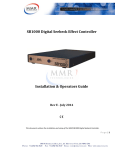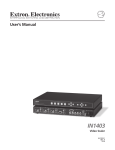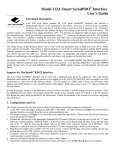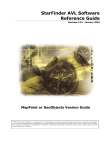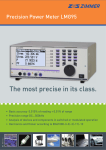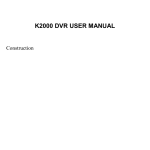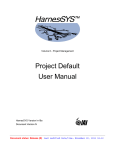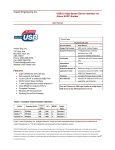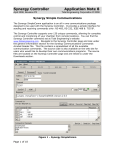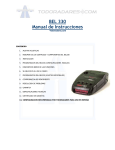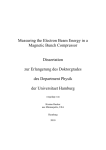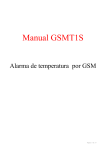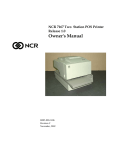Download SB1000InstallationGu..
Transcript
SB1000DigitalSeebeckEffectController Installation&OperatorsGuide RevE‐July2014 This document outlines the installation and setup of the MMR SB1000 Digital Seebeck Controller. P a g e | 1 Phone: +1 (650) 962 9620 41 Daggett Drive, San Jose, CA 95134 Fax: +1 (650) 962-9647 Email: [email protected] Web: www.mmr‐tech.com CONTENTS Specifications System Requirements Environmental and Safety About the SB1000 Digital Seebeck Controller 3 3 3 Hardware Installation Installation Changing Port Numbers in Windows Front / Rear Panel Interface Getting Started 4 5 6 7 General Operation Main Software Suite Interface and Spooler Theory of Operation Stage Preparation Sample Preparation Experiment Setup Seebeck Software Layout Seebeck Software Seebeck Statistics View Communications Protocol 8 9 13 14 15 16 17 18 19 Troubleshooting Troubleshooting Help Desk and MMR Contact Information Declaration of Conformity 21 Additional Information 22 23 P a g e | 2 Phone: +1 (650) 962 9620 41 Daggett Drive, San Jose, CA 95134 Fax: +1 (650) 962-9647 Email: [email protected] Web: www.mmr‐tech.com About the SB1000 Digital Seebeck Controller Specifications The SB1000 Seebeck Effect controller is built on and intended to replace the proven SB100 Seebeck Controller previously offered by MMR Technologies. See Page 9 for the Theory of Operation. This device provides accurate Thermo Electric voltage readings from an MMR Seebeck Stage and Refrigerator assembly. These devices are intended for use with MMR Refrigerators only. Voltage: Power Consumption: Heater Power: Communications: Standalone Operation: Weight: Dimensions: Environmental: 115VAC ‐ 220VAC 50/60Hz (Dual Voltage) 30W 0 ‐ 1W RS232 or USB1.0 (See communications protocol) Yes 5Lbs 8.5"(W) x 1.5"(H) x 14.25"(D) Indoor use only, 5C ‐ 40C Temperature, 2000M Max Altitude, 80% Humidity for temperatures up to 31 °C decreasing linearly to 50 % Rel humidity at 40 °C. System Requirements The SB1000 Seebeck Controller is designed for use with 'MMR Technologies Suite' which must be installed prior to using this device. For custom control of this device see page 19. Please note that MMR may not support custom configurations, and in some cases the warranty may be void. Operating System: Windows 2000, Windows XP, Windows 7, Windows 8 Hardware: 32BIT / 64BIT INTEL or AMD Processor Memory RAM: 2GB Memory Hard Disk: 1GB Peripheral Interface: 1x RS232 Serial or USB1.0. Mac OS: Not Supported Linux / Unix: Not Supported Environmental and Safety The SB1000 Seebeck Effect controller is built on and intended to replace the proven SB100 Seebeck Controller previously offered by MMR Technologies. Please observe the following safety warnings: do not open the enclosure, do not operate on any voltage other than specified, do not attempt to service or modify the equipment, do not operate in wet/damp locations. Warning, electrical shock, injury or death may occur if the device is opened or the earth modified. Use only the cables supplied with the device and ensure a proper Ground is present. The SB1000 should only be used as intended and should not be used for any other purpose. Any non‐intended use could cause fire, loss of life, loss of equipment, and bodily harm. User assumes all risk should the equipment be misused, modified, or used in an unintended manner. Contact MMR for service requirements. P a g e | 3 Phone: +1 (650) 962 9620 41 Daggett Drive, San Jose, CA 95134 Fax: +1 (650) 962-9647 Email: [email protected] Web: www.mmr‐tech.com Hardware Installation Installation Before proceeding please ensure the MMR Technologies Software Suite is installed and the following items are present: 1x SB1000 Seebeck Controller 1x K2000 Temperature Controller (If Temperature control is required) 1x AC Power Cable 1x RS232 DB9 Serial Cable 1x USB 3FT Cable 1x User Manual and Software / Driver Installation CD 1x 4FT Refrigerator Ribbon Cable 1x MMR 4‐Wire Kelvin Connection Breakout Board 1x SB1000 ‐ K2000 Link Cable Please connect the SB1000 as shown below. Do not connect both the RS232 Serial cable and USB cable simultaneously, these are provided as an option should you be short of spare PC ports. Once connected and with the PC Running, you may now power up the SB1000 device. Please first ensure the AC Power switch at the rear of the unit is 'ON' (see page 6 for further information). Press the front button labeled 'Power' to activate the unit. If the USB cable was used, Windows will automatically assign a Comm Port. This must be identified and, if necessary, changed to be in the range of 1‐16 (See page 5 or contact your system administrator). Please note down the assigned Comm Port Number as this will be required to communicate with the device. P a g e | 4 Phone: +1 (650) 962 9620 41 Daggett Drive, San Jose, CA 95134 Fax: +1 (650) 962-9647 Email: [email protected] Web: www.mmr‐tech.com Hardware Installation Changing Port Numbers in Windows (Note: Administrator access maybe needed, contact your IT department) 1/. Open Device Manager. (Control Panel ‐> Device Manager) 2/. Select the corresponding Serial Converter Device. (Right Click ‐> Left Click Properties) 3/. Click on the 'Port Settings' Tab. 4/. Click Advanced. 5/. Select a Comm Port between 1 ‐ 16 that is not in‐use by other hardware. Click OK. (Note: On some computers you may need to disconnect (unplug) and reconnect the device to make the changes permanent) P a g e | 5 Phone: +1 (650) 962 9620 41 Daggett Drive, San Jose, CA 95134 Fax: +1 (650) 962-9647 Email: [email protected] Web: www.mmr‐tech.com Hardware Installation Front / Rear Panel Interface Note: The Power button must be held for 3 seconds to power down the unit. *Replace fuse with 3.15A Slow Blow (IEC 127‐2 or similar) ONLY. P a g e | 6 Phone: +1 (650) 962 9620 41 Daggett Drive, San Jose, CA 95134 Fax: +1 (650) 962-9647 Email: [email protected] Web: www.mmr‐tech.com Hardware Installation Getting Started Step 1 ‐ Device ports are easily verified through the welcome screen above. Select the port number the SB1000 Seebeck Controller is connected to (shown as present next to the SB1000) and press 'Poll'. If the SB1000 is connected to that port and powered on, it will respond with a Device name and Version number. If the port number is not visible try refreshing the port list by clicking the refresh icon above the "Poll'' buttons. If this does not resolve the issue try restarting the computer. For further assistance contact your system administrator and finally, the MMR Helpdesk (See contact information on Page 27). Step 2‐ Select 'Seebeck Experiment.' This will load the Seebeck experiment module. If there is no K2000 present, deselect "K2000' under hardware. This will disable temperature control for all Seebeck experiments. Errors will occur if K2000 remains selected when not present. Step3 ‐ Press 'Begin P a g e | 7 Phone: +1 (650) 962 9620 41 Daggett Drive, San Jose, CA 95134 Fax: +1 (650) 962-9647 Email: [email protected] Web: www.mmr‐tech.com General Operation Main Interface The main interface of the MMR Technologies Suite is shown above. This is the primary container for all MMR applications. The applicable items for the SB1000 Temperature Controller are shown above. SB1000 Spooler [Main Suite ‐> SB1000 ‐ > Show Spooler] This window shows the communications queue and response from the associated device; in this case the SB1000 Seebeck Controller. Troubleshooting is the primary use for this window. However clicking "Send" is a short cut to the ‘Main Communications Console' outlined in the Software Installation Guide. P a g e | 8 Phone: +1 (650) 962 9620 41 Daggett Drive, San Jose, CA 95134 Fax: +1 (650) 962-9647 Email: [email protected] Web: www.mmr‐tech.com General Operation Theory of Operation The system described below measures the thermo voltage (Seebeck Voltage) of metals and semiconductors. It also provides the user with the opportunity to study the temperature dependence of the Seebeck Voltage for different materials. Below is a picture of the Seebeck Stage which i s attached to the cold stage of the MMR refrigerator. Low Temperature Kapton Stage High Temperature Ceramic Stage Theory of Operation The Seebeck Stage has two pairs of thermo couples: one of copper and a metal with known properties, and the other pair of copper and a metal with properties to be determined. One of the junctions in each pair is considered a reference junction, and the other the working or temperature modulated junction. The Stage also has a computer controlled heater, located close to the working junctions of each pair, and remote from the reference junctions. This heater is controlled by the MMR Programmable Seebeck Controller SB1000. The Seebeck stage is attached to the cold stage of an MMR refrigerator, which provides a given stable temperature for the measurement. The MMR Cold stage is controlled by the MMR K20000 Digital Temperature Controller. The Seebeck Stage has two outputs: V 1 and V2, which are monitored by a computer through the SB1000. The principle of operation is the following: assume that all four thermocouples are at the same temperature. Then V1 and V2 will be zero because each member of each pair of thermocouples compensates the voltage of the other. If power is applied to the heater, then a temperature difference will be created between the working and the reference junctions because they are located at different distances from the heater. As a result, thermo voltages will be generated in each pair giving non zero output voltages VI and V2. These are given by: (1). V1 = ε1 ∆ T (P) and (2). V2 = ε2 ∆ T (P) Where ε1 and ε2 are the specific thermo‐voltages of the sample and known thermocouples respectively, and Δ T(P) is the temperature difference between the working and the reference junctions created by applying power (P) to the computer controlled heater. We expect, that the temperature difference Δ T(P) will be the same for both pairs because the stage has a symmetrical shape. The value of the specific thermo‐voltage of the unknown junction is then: (3). ε1 = ε2 V1/V2 P a g e | 9 Phone: +1 (650) 962 9620 41 Daggett Drive, San Jose, CA 95134 Fax: +1 (650) 962-9647 Email: [email protected] Web: www.mmr‐tech.com General Operation However, one should use a small temperature deviation Δ T in order to obtain representative data in the temperature domain. Therefore, the values of V 1 and V2 will also be small. Because of this, a direct measurement will not give high accuracy because of instrumental errors, and any undesired thermo‐voltage effects from wires, connectors, etc. These effects can create substantial offset voltages which, in addition to the temperature drifts and offsets of the input amplifiers, can contribute a major source of measurement error. These can be eliminated, however, by taking measurements at two different temperature offsets, using two different power settings, and then using the difference signal. We show this as follows; the real values of V1 and V2 acquired by the SB1000 are given by: (4). V1(P1) = ε1 ∆ T (P1) + ∆ V1 and (5). V2(P2) = ε2 ∆ T (P2) + ∆ V2 Where Δ V1 and Δ V2 are the instrument and extraneous thermal offset voltages discussed above, and P1 is the power applied to the heater at the first measurement point. Now, if the heater power is changed to a new value P2 , we obtain a second pair of values for V 1 and V2: (6). V1(P2) = ε1 ∆ T (P2) + ∆ V1 and (7). V2(P2) = ε2 ∆ T (P2) + ∆ V2 The offset voltages ΔV 1 and ΔV2 can be assumed to be independent of power P, because only the temperature in the immediate neighborhood of the reference and sample junctions change, not those where these other offset voltages originate. Subtracting equations (6) and (7) from (4) and (5), respectively, we obtain the true value of ε1 from the following: (8). ε1 = ε2 {V1(P1) ‐ V1(P2) } / {(V2(P1) ‐ V2(P2)} (8) does not include ΔV 1 and ΔV2. The offsets have been removed. Certain hardware and software precautions have also been implemented to eliminate any possible electrical coupling between the heater and measurement circuits as well. P a g e | 10 Phone: +1 (650) 962 9620 41 Daggett Drive, San Jose, CA 95134 Fax: +1 (650) 962-9647 Email: [email protected] Web: www.mmr‐tech.com General Operation Measurement Process: (Data collected in green areas) The power or the heater P(t) is changed from zero to level P. V1 and V2 are plotted schematically to show the corresponding changes of the thermo‐voltages , as the temperature of the working junctions change. The green areas show the time intervals during which readings are taken. The average value of V1 and V2 for power levels 0 and P are used at the end of every period to calculate the specific thermo‐voltage of the sample. The initial and operating time delays provide time for the system to stabilize thermally before taking the data. The MMR Seebeck System allows the temperature of the MMR Cold Stage and attached Seebeck Stage to be controlled over a wide temperature range. One can thus study the temperature dependence of the specific thermo voltage of the samples by repeating the measurements at a series of temperatures. The Seebeck System allows this to be done automatically. Definitions. In the following, various terms used in this Manual and in the operation of the System are defined. 1. Measurement point. The set temperature for the Seebeck stage provided by the MMR Cold Stage. Different measurement points are used in order to study the temperature dependence of the specific thermo‐voltage. 2. Experiment. The process that includes a sequence of measurement points; starting from the Initial Temperature and finishing with the Final Temperature. Including data acquisition at every measurement point, calculation and final presentation of the results. 3. Initial and Final Temperatures. These temperatures set the range of the data acquisition process. If the Initial Temperature is less than the Final Temperature, then the sample will be heated during data collection. If the Final Temperature is lower, then the sample will be cooled. The Initial and Final Temperatures are always displayed during the experiment. The permitted range of the settings for these temperatures depends on the type of Thermal Stage used. Refer to the corresponding data sheets. P a g e | 11 Phone: +1 (650) 962 9620 41 Daggett Drive, San Jose, CA 95134 Fax: +1 (650) 962-9647 Email: [email protected] Web: www.mmr‐tech.com General Operation 4 . Stand‐by Temperature. The temperature to which the Seekbeck stage is to be set after the experiment is completed. 5. Current Temperature. The actual, present temperature of the Cold Stage. 6. Target Temperature. The temperature at which the present activity of the system is targeted. It can be the Initial Temperature, the Measurement point Temperature, or the Standby Temperature. The temperature setting process is complete when the Current Temperature is equal to the Target Temperature. 7. Current Power. The power being applied presently to the MMR Cold Stage by the ‘K2000 MMR Temperature Controller.' 8. Temperature Step. The difference between two successive measurement points. 9. Sweep Speed (Ramp Rate). The rate at which the temperature is changed from one measurement point to the next. 10. Modulation Power. The value of the power applied to the Seebeck stage heater to produce a temperature gradient across the samples. 11. Initial Time Delay. The waiting period from the time the Cold Stage reaches the measurement temperature, until the system takes the first set of readings. This delay is needed to allow the Seebeck Stage to reach equilibrium with the Cold Stage. 12. Operating Time Delay. The waiting period from the time the Seebeck Stage heater is turned on, until the second set of readings are taken. This allows a steady state to be reached across the Seebeck Stage. 13. Reference Thermo‐Voltage. The specific thermo voltage (Seebeck Coefficient) of the known junction; used in the Seebeck Stage as a reference. Since this parameter changes with temperature, the data acquisition software includes a file with a look‐up table to provide the value which corresponds to that for the set temperature. The Standard MMR Seebeck System is supplied with a lookup table for Constantan (as the reference material) relative to copper along with Constantan relative to PdAg. 14. Averaging Parameter. The parameter that defines the number of acquired data readings made during the measurement time interval, which are subsequently averaged at one measurement point. The parameter can vary from 0 to 7. The actual number of data readings is calculated as a corresponding power of 2, so a parameter 0 means 2°, or one reading, while a parameter 7 means 27, or 128 readings. MMR Recommends a setting of '2' for most experiments. P a g e | 12 Phone: +1 (650) 962 9620 41 Daggett Drive, San Jose, CA 95134 Fax: +1 (650) 962-9647 Email: [email protected] Web: www.mmr‐tech.com General Operation Stage Preparation 1. Stage Installation. 1.1. Remove a Seebeck Stage from the package. 1.2. Put a thin layer of thermal grease on the large Copper plate (underside). 1.3. Unlock the ZIF connector (if present) on the pre‐amplifier board in the vacuum chamber. Using thumbs on each side of the connecter, insert the Seebeck stage fully. 1.4. Affix the Seebeck Stage to The Cold Stage by the spring fasteners. Be extremely careful! Do not apply any downward force on the refrigerator. Use tweezers to adjust the fasteners during installation. You can move the Seebeck Stage backwards and forwards by a couple of millimeters to get the best location. 1.5. Lock the ZIF connector (if present). 1.6. Install the cover on the vacuum chamber. 2. Connect the Ribbon cable from the Chamber to the SB1000. If a K2000 is present for temperature control, ensure the Link Ribbon Cable is installed from the SB1000 to the K2000. 3. If you are going to use the system at temperatures below ambient, you should also install all system components required for cooling according to the MMR Refrigerators Manual. P a g e | 13 Phone: +1 (650) 962 9620 41 Daggett Drive, San Jose, CA 95134 Fax: +1 (650) 962-9647 Email: [email protected] Web: www.mmr‐tech.com General Operation Sample Preparation The MMR Seebeck System can be used for measurement of the Seebeck coefficient of a wide range of different conductive substances, metals, organic conductors, and semiconductors. Samples should be in the form of a thin strip or wire to be installed on the Seebeck Stage. The actual dimensions and the shape of samples are not critical, but should be considerably smaller than the Seebeck stage itself. We recommend that the width of the samples not exceed 1mm (40 mils), and the length 5 mm (200 mils). For proper installation of the samples, good electrical and thermal contacts must be provided at both ends of the sample to the Seebeck Stage Areas (shown below). The unknown sample should be installed to the left or the Seebeck Stage center, and the reference sample to the right. Do not switch these locations; otherwise you will get completely incorrect results! For attaching the samples to copper surfaces, one can either use regular soldering alloys, or electrically/thermally conductive cement or epoxy. The bonding substance should be able to withstand the temperature range of the proposed measurements. Materials of high specific resistivity and low thermal conductivity should not be used. The resistance of the sample plus the bonding material to the Seebeck Stage should be less than 100Kohm. Install the unknown sample first, using the bonding material of your choice, The working junction should be located as close as possible to the slot that separates the two copper surfaces of the unknown and reference samples (see page 10), The location of the other end of the sample is much less critical. If the sample cannot be formed or folded, attach it at any convenient point on the copperplate which is common to the unknown and reference samples, and as close to the center as possible. Install the reference sample in a similar manner. Cut approximately 5 millimeters (0.2") of the reference material wire supplied with the System. For the standard Seebeck System version this is a wire of Constantan. Attach one end of the wire piece to the copper plate which is common to both samples. Use the same point as for the unknown sample. The unknown and reference samples should have direct thermal contact in this point. Attach the other end of the reference sample taking into account the same considerations as for the tested sample .The working junctions of both samples should have symmetrical locations relative to the stage heater. Finally, using an appropriate fluid, clean the Seebeck Stage of possible surface contamination. We recommend the use of Freon's and/or methyl or ethyl alcohol. Any cleaning materials used must be non‐conductive. Notice: Be very careful while mounting the samples. Bad electrical or thermal contacts, asymmetrical location of the working junctions, and surface contamination can cause serious measurement errors. P a g e | 14 Phone: +1 (650) 962 9620 41 Daggett Drive, San Jose, CA 95134 Fax: +1 (650) 962-9647 Email: [email protected] Web: www.mmr‐tech.com General Operation Experiment Setup New Project As mentioned in the Seebeck Definitions on Page 12, the Experiment parameters can now be entered. If no K2000 Temperature Controller is present select 'Skip Temperature Settings,' this will carry out the experiment at Ambient Temperature (300K will be used for all calculations). Sample Mounting Stage: Select the appropriate stage type that the sample is mounted on. High Impedance Input: Select the appropriate Impedance Setting that relates to the Amplifier in use. Gain: Select the appropriate Gain value that relates to the Amplifier in use. Note: Impedance and Gain settings are indicated on the Amplifier board inside the chamber. The correct settings must be used or erroneous data will result. Click 'OK' P a g e | 15 Phone: +1 (650) 962 9620 41 Daggett Drive, San Jose, CA 95134 Fax: +1 (650) 962-9647 Email: [email protected] Web: www.mmr‐tech.com General Operation Seebeck Software Layout Experiment View Before selecting 'Start' check the voltages and temperature data (if a K2000 is present), and check the SB1000 status in the 'Experiment Setup' box to verify proper communication ('Ready'). As shown above, the voltages are close to 0 and equal. Improper material mounting will cause erroneous voltages. If 'Auto Standby' was selected the 'K2000 Temperature Controller' will first set the Standby Temperature. Selecting start will begin the Automated Data Collection process. The progress and status will be shown on the right hand side of the Experiment window. If the experiment is 'Started' before the standby temperature is reached, the experiment will wait until the temperature is reached and then begin automatically. If a K2000 Temperature Controller is present, the temperature plot will automatically begin recording temperature data. P a g e | 16 Phone: +1 (650) 962 9620 41 Daggett Drive, San Jose, CA 95134 Fax: +1 (650) 962-9647 Email: [email protected] Web: www.mmr‐tech.com General Operation Seebeck Software The above 'Complete' Experiment shows the data collected. The user has the option of : 1/. Saving the data to the internal database to retrieve later (Main Suite ‐> SB1000 ‐> Open). 2/. Printing the Data (in Data View click 'Print ') 3/. Printing the Plot (in Graph View click 'Print') 4/. Exporting Data to Comma Separated Values (in Data View click 'Export .csv') for further analysis in third party software such as Microsoft Excel. 5/. Viewing statistics, (in Data View click 'Statistics') Note: Some options are only available when the Experiment has completed successfully. The above plot shows the Temperature Control during the Seebeck Experiment. This data can be printed from within the K2000 Temperature Graph Window if needed. P a g e | 17 Phone: +1 (650) 962 9620 41 Daggett Drive, San Jose, CA 95134 Fax: +1 (650) 962-9647 Email: [email protected] Web: www.mmr‐tech.com General Operation Seebeck Software Statistics The above Statistical Results view displays the Average Values at every Temperature point. Standard Deviation is also present along with the Percentage Change and Min Max Values. If no temperature control is present only 1 point will be plotted. P a g e | 18 Phone: +1 (650) 962 9620 41 Daggett Drive, San Jose, CA 95134 Fax: +1 (650) 962-9647 Email: [email protected] Web: www.mmr‐tech.com General Operation Communications Protocol Main Communications Type: Communications Interfaces: Serial Settings: Handshaking: Echo: Bus Pairing: Hardware CTS Timeout: Data Format: Serial RS232, USB1.0 9600,N,8,1 Hardware RTS/CTS Yes Parallel 1000ms ASCII / Plain Text System Commands Command Format Example Description SM SMX SM1 (1‐7) Averaging Parameter 2^n Readings Start Measurement GV GVX GV1 (1 or 2) Valid when unit is in standby. Get Voltage SH SHXXX SH300 (300mW) Set Heater N N1 Get Device ID O O1 Power Down Unit Note: Sending command SMx starts constant measurement at desired average rate. Communications & Byte Order Command Example: 'SM2' (starts measurement at 2^2 = 4 readings per average) 1/. Set RTS High 2/. Wait for CTS 3/. Send 'S' as a Character (VB Example on Next Page) 4/. Send 'M' as a Character (VB Example on Next Page) 5/. Send Average as a 2‐Byte Word (Highbyte First, Lowbyte Second) 6/. Set RTS Low P a g e | 19 Phone: +1 (650) 962 9620 41 Daggett Drive, San Jose, CA 95134 Fax: +1 (650) 962-9647 Email: [email protected] Web: www.mmr‐tech.com General Operation Communications Protocol Visual Basic Example ‐ Sending a start measurement command. 'SM2' Private Sub Form_Load() MSComm1.CommPort = 2 MSComm1.DTREnable = False MSComm1.Settings = "9600,N,8,1" MSComm1.RTSEnable = False MSComm1.OutBufferSize = 1024 MSComm1.RThreshold = 1 MSComm1.SThreshold = 0 MSComm1.PortOpen = True End Sub Function StartMeasurement() Dim command As Long Dim var As Integer Dim counter As String val = 2 'Start Measurement 2^2 counter = 0 MSComm1.RTSEnable = True 'Set RTS High While MSComm1.CTSHolding <> True counter = counter + 1 'Wait for CTS Signal If counter > 200000 Then MSComm1.RTSEnable = False 'Reset RTS MsgBox ("Time Out") Exit Function End If Wend MSComm1.OutBufferCount = 0 MSComm1.InBufferCount = 0 'Clear Buffers MSComm1.Output = Chr$(S) + Chr$(M) + Chr$(val / 256) + Chr$(val Mod 256) MSComm1.RTSEnable = False End Function P a g e | 20 Phone: +1 (650) 962 9620 41 Daggett Drive, San Jose, CA 95134 Fax: +1 (650) 962-9647 Email: [email protected] Web: www.mmr‐tech.com Troubleshooting Troubleshooting Symptom Solution Cannot Communicate with SB1000 Ensure Unit is properly connected and powered on. Press Reset. Check that the device is connected to the correct Communications Port and the drivers are successfully loaded. No Lights on SB1000 Ensure Unit is plugged into an AC Power source, and the rear power switch is on. Check Fuse. Readings are unstable Check refrigerator is under vacuum. Check sample mounting quality Refrigerator doesn't Cool or Heat Refer to Refrigerator Operators Manual, and check for damage to refrigerator. Temperature Accuracy has degraded Return Refrigerator to MMR for Sensor service. Software has an Error message Contact MMR helpdesk For all other errors or issues please contact the MMR Help Desk (see Page 22) P a g e | 21 Phone: +1 (650) 962 9620 41 Daggett Drive, San Jose, CA 95134 Fax: +1 (650) 962-9647 Email: [email protected] Web: www.mmr‐tech.com Troubleshooting Help Desk and MMR Contact Information Help Desk Email Address: Bug Reporting: Technical Support Email Address: Sales & Marketing Department: Help Desk: Office Hours: Physical Address: support@mmr‐tech.com spdbugs@mmr‐tech.com matt@mmr‐tech.com sales@mmr‐tech.com +1 650 962 9620 7:30am ‐ 5:00pm (Pacific Time) Monday ‐ Friday 41 Daggett Drive, San Jose, California 95134 USA P a g e | 22 Phone: +1 (650) 962 9620 41 Daggett Drive, San Jose, CA 95134 Fax: +1 (650) 962-9647 Email: [email protected] Web: www.mmr‐tech.com Declaration of Conformity Declaration of Conformity Manufacturer: MMR Technologies Model Name: SB1000 Date: July 2014 Expires: July 2018 UL / IEC 61010 Application of Council Directives: Low Voltage Directive (LVD) 2006/95/EC Standards to which Conformity is Declared: IEC EN 61010‐1 3rd Edition Electrical equipment for measurement, control, and laboratory use Pressure Equipment Directive (97/23/EC) Conformity is declared to Annex I Essential Requirements of the Directive Application of Council Directives: Electromagnetic Compatibility Directive (EMC) 2004/108/EC Conformity is declared to Annex I and II (EMC) 2004/108/EC P a g e | 23 Phone: +1 (650) 962 9620 41 Daggett Drive, San Jose, CA 95134 Fax: +1 (650) 962-9647 Email: [email protected] Web: www.mmr‐tech.com























